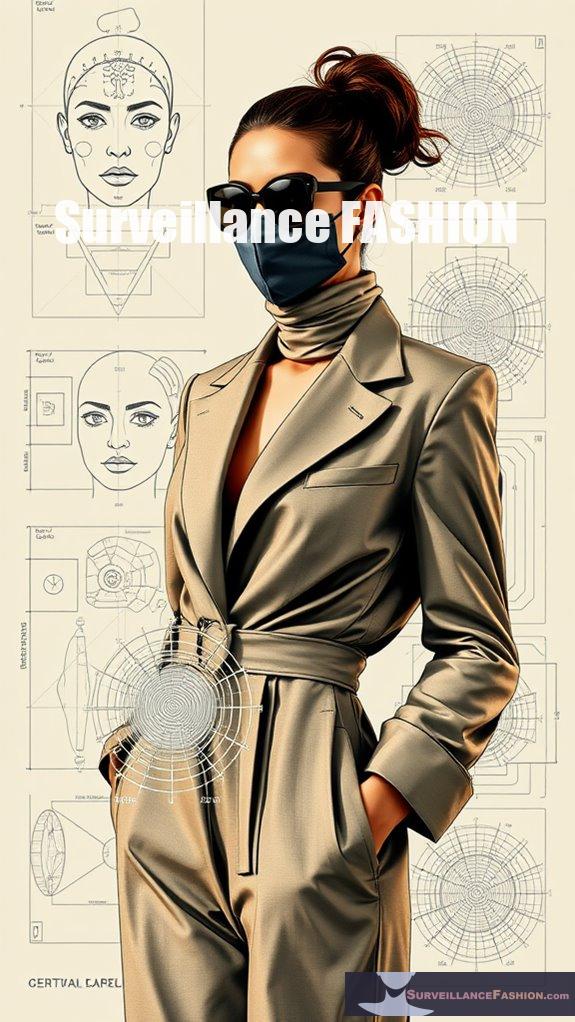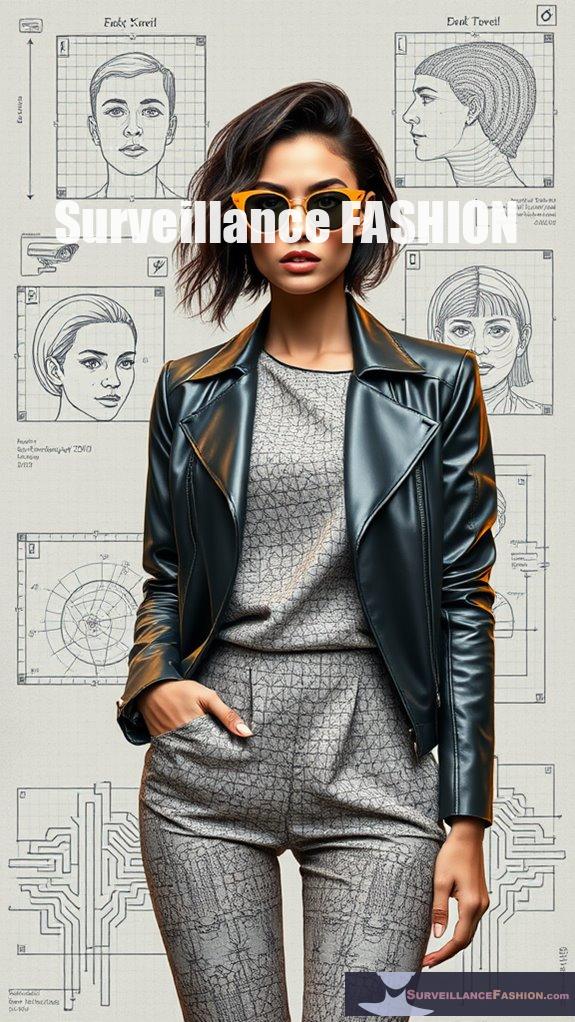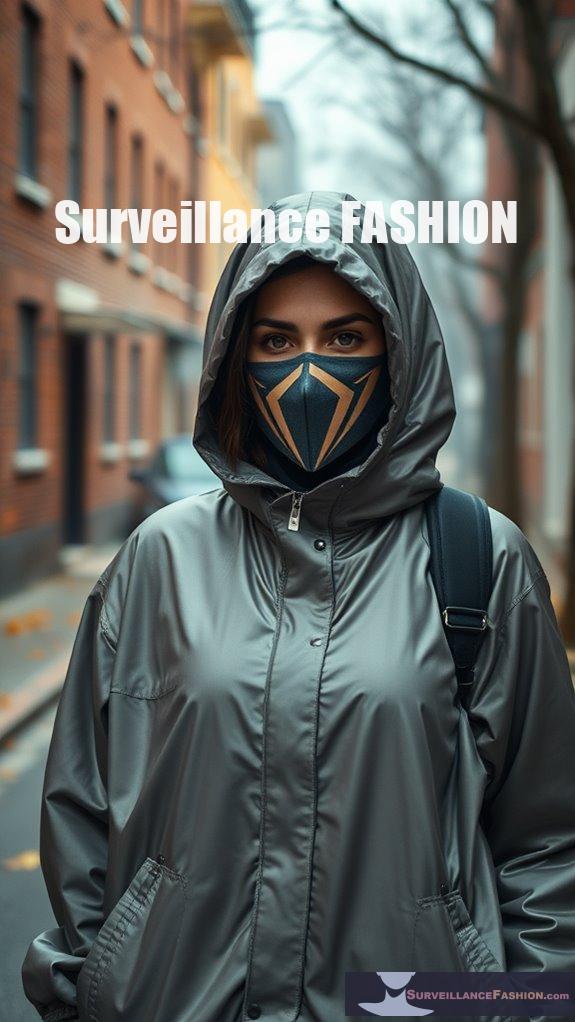Communities can employ several tactics to resist facial recognition technology effectively. First, adopt everyday resistance techniques, like wearing clothing that obscures identity. Second, engage in grassroots activism, advocating for bans on biometric surveillance. Third, organize educational workshops to inform locals about privacy rights. Fourth, utilize fashion innovations, such as the Hyperface Project, to confuse detection systems. Fifth, document instances of misuse through reverse surveillance. By fostering collective action, you contribute to a stronger push against invasive technologies. Explore more strategies that empower communities to reclaim privacy.
Quick Takeaways
- Organize community workshops to educate residents about facial recognition technology and privacy rights implications.
- Form coalitions to advocate for local bans on government facial recognition use and raise awareness about civil liberties.
- Utilize fashion and wearable technology, like Anti-Paparazzi Scarves, to disrupt surveillance systems while promoting privacy rights.
- Engage in grassroots activism to support legislative initiatives aimed at halting facial recognition technology and promoting digital privacy.
- Collaborate with NGOs to influence policy changes and mobilize public opinion against invasive surveillance practices.
Everyday Resistance Techniques

Everyday resistance against facial recognition technology manifests in a variety of techniques that individuals can employ to reclaim their privacy and protect their anonymity.
To assert your digital anonymity, consider adopting practices that obscure your identity in public spaces, such as wearing masks or using clothing designed to disrupt facial recognition algorithms. These tactics are especially important given that face recognition technology has led to wrongful arrests of individuals, particularly among marginalized communities. Additionally, it's crucial to recognize that privacy-preserving techniques can significantly reduce the effectiveness of surveillance systems.
Engaging in privacy advocacy, you might also support local initiatives aimed at banning government use of this technology, reflecting a collective desire for autonomy over personal data.
Furthermore, participating in community discussions about the implications of surveillance can amplify awareness, fostering a culture that prioritizes consent and transparency.
Exploring artistic expressions that challenge these technologies can contribute to a broader resistance ethos, aligning with the objectives of platforms like Surveillance Fashion, which promote creative countermeasures against invasive surveillance practices.
Distortion Methods for Evading Surveillance

While the rise of facial recognition technology has heightened privacy concerns, a variety of distortion methods exist that individuals can employ to evade surveillance effectively.
Physical disguises, such as hats, glasses, or specially designed masks, can obscure facial features, complicating recognition. You can also use contrasting makeup techniques to alter contours or change skin tone, enhancing your anonymity. Facial recognition systems rely heavily on quality input data, which means that even minor alterations can significantly improve your chances of evading detection. Makeup techniques can be particularly effective when applied strategically to disrupt the facial symmetry that these systems depend on.
Physical disguises and makeup techniques can effectively obscure your features, enhancing your anonymity in a world of surveillance.
Digital manipulation plays a crucial role, too; deepfakes can create altered images that confuse algorithms.
Additionally, innovative accessories like infrared LED glasses disrupt camera functions, ensuring your identity remains concealed.
As we continue to explore these strategies, our website, Surveillance Fashion, aims to empower individuals with knowledge about personal privacy tactics, enabling you to reclaim control over your image in an increasingly monitored world.
Blocking Moves: Activism Against Surveillance Infrastructure

As communities become increasingly aware of the pervasive nature of surveillance infrastructure, they're mobilizing to challenge and dismantle facial recognition technologies.
Through the formation of community coalitions, individuals are uniting to advocate for digital privacy and resist invasive monitoring practices.
For instance, grassroots activism has led to successful bans on government facial recognition in over twenty U.S. cities, demonstrating the power of collective action.
Global campaigns, such as Amnesty International's *Ban the Scan*, have amplified these efforts, urging a halt to facial recognition surveillance in public spaces.
In tandem, legislative initiatives, including the Facial Recognition and Biometric Technology Moratorium Act, are gaining traction, asserting communities' rights to regulate the technologies that impact their lives directly, thereby reclaiming their autonomy. The development of community-led countermeasures is essential in fostering resilience against surveillance technologies.
Reverse Surveillance: Documenting Misuse

In an era where surveillance technologies dominate public spaces, documenting the misuse of facial recognition has become an essential countermeasure against the encroachment on civil liberties. This misuse documentation serves not only as a record of civil rights violations but also as a tool for accountability, enabling communities to challenge the unchecked power of law enforcement.
Establishing robust reporting channels allows individuals to report instances of misuse, fostering a culture of transparency and vigilance. For instance, civil rights commissions can leverage these reports to address systemic issues, while advocacy groups utilize the collected data to push for policy changes. Additionally, communities can adopt strategies for facial obfuscation methods that enhance privacy and protect individual identities from intrusive surveillance practices.
Organizing Protests for Collective Action

Organizing protests against facial recognition technology becomes a pivotal strategy for communities seeking to reclaim their civil liberties, particularly in a terrain increasingly dominated by surveillance.
To effectively mobilize, you'll need to focus on protest logistics and coalition building, ensuring diverse groups unite under a common cause. Start by coordinating with local organizations that share your concerns regarding civil liberties, allowing for a more robust turnout.
Focus on coalition building and logistics to unite diverse groups in a powerful, collective stand for civil liberties.
Utilizing creative tactics—such as patterned clothing to disrupt recognition systems—can enhance your visibility while minimizing risks.
Additionally, disseminating information about the implications of facial recognition through social media campaigns can raise public awareness, further galvanizing support for policy reforms. These efforts can include discussions about identity protection techniques, which equip individuals with the knowledge to safeguard their privacy.
Through your combined efforts, community-driven initiatives like Surveillance Fashion can challenge oppressive surveillance practices and advocate for policy change.
Community Engagement and Education Initiatives

Understanding the implications of facial recognition technology requires not just knowledge, but also active community engagement and education initiatives that empower individuals to navigate this complex environment.
Community workshops can serve as essential platforms for educating participants about how facial recognition works, alongside its potential implications on privacy rights. These workshops not only provide practical strategies for evading surveillance but also foster discussions concerning ethical concerns, which in turn enables informed decision-making.
Moreover, educational resources, including literature and online platforms, can amplify awareness of privacy violations and the biases inherent in these technologies. Additionally, organizing community coalitions can strengthen collective resistance efforts against surveillance practices and promote a united front in advocating for privacy rights.
Collaborating With NGOS for Policy Change

While the rise of facial recognition technology prompts significant concerns regarding privacy and civil liberties, collaborating with non-governmental organizations (NGOs) offers a strategic avenue for communities seeking policy change.
Through NGO partnerships, communities can engage in policy advocacy aimed at establishing legal frameworks that protect individuals from invasive surveillance tactics. By mobilizing grassroots support and raising public awareness, NGOs can effectively influence corporate decisions, urging companies to halt their sales of facial recognition technology. Moreover, the impact of surveillance on civil liberties can serve as a powerful motivator for community action.
| Collaboration Strategies | Effective Policy Change |
|---|---|
| Common Goals | Multistakeholder Engagement |
| Grassroots Support | Evidence-Based Interventions |
| Public Awareness | Legal Frameworks |
| Influencing Corporate Decisions | Transparency and Accountability |
| Government Lobbying |
These collaborations harness collective power, transforming community concerns into actionable policy initiatives.
Fashion That Obscures Identity

Emerging as an innovative response to the pervasive threat of facial recognition technology, fashion that obscures identity represents a unique intersection of art, activism, and technology. This anti-surveillance fashion not only challenges identity disruption but also empowers you to reclaim your privacy. Consider these options:
- Cap_able's Manifesto Collection, using AI patterns to mislead facial recognition systems.
- Hyperface Project textiles, which confuse software by displaying multiple facial features.
- Anti-Paparazzi Scarves, designed with reflective materials that disrupt camera detection.
These garments exemplify how fashion can actively resist surveillance, while also serving as a medium for raising awareness about privacy rights. As the demand for digital identity protection grows, designers continue to innovate in this crucial area.
Collective Style Against Surveillance

As communities increasingly confront the encroachment of surveillance technologies, collective style emerges as an essential form of resistance, uniting creativity and activism in a shared effort to protect privacy rights.
By harnessing community art, groups engage in public displays that challenge facial recognition, often through artistic protests and interactive installations. These projects not only raise awareness but also foster a sense of agency among participants, empowering them to reclaim their narratives through digital storytelling.
For instance, educational initiatives inform the public about the implications of surveillance, while collaborative actions encourage collective monitoring of these technologies to guarantee ethical use. Additionally, adopting recognition avoidance strategies can significantly bolster community efforts against invasive surveillance practices.
Such efforts exemplify how art and activism can intertwine, forming an effective front against the pervasive reach of surveillance systems, which we aim to address through our platform, Surveillance Fashion.
References
- https://wiki.digitalrights.community/index.php?title=Resisting_Public_Space_Surveillance:_Fostering_privacy_and_anonymity_in_the_age_of_mass_video_and_facial_recognition_surveillance
- https://opentextbc.ca/writingforsuccess/chapter/chapter-9-citations-and-referencing/
- https://www.amnesty.org/en/latest/press-release/2021/01/ban-dangerous-facial-recognition-technology-that-amplifies-racist-policing/
- https://portal.cops.usdoj.gov/resourcecenter/content.ashx/cops-w0047-pub.pdf
- https://www.ucl.ac.uk/news/2022/feb/facial-recognition-technology-reinforces-discriminatory-policing-new-york
- https://resistance-journal.org/wp-content/uploads/2020/01/JRS-2-2019-Recognizing-Everyday-Activism.pdf
- https://www.eff.org/deeplinks/2021/10/resisting-menace-face-recognition
- https://www.cigionline.org/articles/how-facial-recognition-technology-permeated-everyday-life/
- https://www.ucsiuniversity.edu.my/sites/default/files/the-elements-of-academic-style.pdf
- https://www.brookings.edu/articles/10-actions-that-will-protect-people-from-facial-recognition-software/
- https://bluegoatcyber.com/blog/fooling-facial-recognition-exploring-vulnerabilities/
- https://luxand.cloud/face-recognition-blog/how-to-fool-and-avoid-facial-recognition-in-public-places
- http://biometrics.cse.msu.edu/Publications/Face/WenHanJain_FaceSpoofDetection_TIFS15.pdf
- https://www.turing.ac.uk/sites/default/files/2023-05/attacks_against_facial_recognition_systems_technical_briefing_final_copyedit.pdf
- https://www.aclu.org/news/privacy-technology/grassroots-activists-are-leading-the-fight-to-stop-face-recognition-its-time-for-congress-to-step-up-too
- https://www.aclu.org/news/topic/stopping-face-recognition-surveillance
- https://www.eff.org/deeplinks/2019/12/activists-worldwide-face-against-face-recognition-2019-year-review
- https://www.usccr.gov/files/2024-09/civil-rights-implications-of-frt_0.pdf
- https://www.178wing.ang.af.mil/Portals/69/documents/afh33-337.pdf?ver=2016-12-15-101008-313
- https://www.aclu.org/news/privacy-technology/when-it-comes-to-facial-recognition-there-is-no-such-thing-as-a-magic-number

Leave a Reply